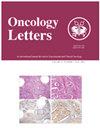SCGB1A1是一种新型生物标记物,也是治疗HNSCC的有望靶点。
IF 2.5
4区 医学
Q3 ONCOLOGY
引用次数: 0
摘要
头颈癌(HNC)是全球第六大常见癌症类型,头颈部鳞状细胞癌(HNSCC)占 HNC 病例的 90%。此外,HNSCC 每年导致全球 40 万人死于癌症。然而,目前还没有一种可用于诊断、预后评估和作为 HNSCC 治疗靶点的多功能生物标记物。在本研究中,生物信息学分析被用来评估 HNSCC 患者的枢纽基因与临床特征之间的关系。然后利用临床样本和体外实验验证了生物信息学分析的结果。从差异表达基因和共表达基因的交叉点中共发现了 51 个重叠基因。从重叠基因的蛋白质-蛋白质相互作用网络中获得了前10个中心基因。在这些中心基因中,只有泌乳素球蛋白家族1A成员1(SCGB1A1)与总生存期和无病生存期显著相关。具体来说,SCGB1A1表达水平的上调与总生存期和无病生存期的延长有关。此外,SCGB1A1表达水平与药物敏感性呈负相关。值得注意的是,研究表明 SCGB1A1 通过影响细胞浸润和免疫细胞的检查点调节参与了肿瘤免疫反应。此外,研究还表明,SCGB1A1 调控多种关键的癌症相关信号通路,包括细胞外基质受体相互作用、转化生长因子-β和肿瘤代谢信号通路。根据本研究的结果,SCGB1A1 可作为一种新型生物标记物,用于预测 HNSCC 患者的诊断、预后和某些药物的疗效。此外,SCGB1A1 还可能成为治疗 HNSCC 的潜在治疗靶点。本文章由计算机程序翻译,如有差异,请以英文原文为准。
SCGB1A1 as a novel biomarker and promising therapeutic target for the management of HNSCC.
Head and neck cancer (HNC) is the sixth most common type of cancer worldwide, and head and neck squamous cell carcinoma (HNSCC) accounts for 90% of HNC cases. Furthermore, HNSCC accounts for 400,000 cancer-associated deaths worldwide each year. However, at present there is an absence of a versatile biomarker that can be used for diagnosis, prognosis evaluation and as a therapeutic target for HNSCC. In the present study, bioinformatics analysis was used to assess the relationship between hub genes and the clinical features of patients with HNSCC. The findings from the bioinformatics analysis were then verified using clinical samples and in vitro experiments. A total of 51 overlapping genes were identified from the intersection of differentially expressed genes and co-expressed genes. The top 10 hub genes were obtained from a protein-protein interaction network of overlapping genes. Among the hub genes, only secretoglobin family 1A member 1 (SCGB1A1) was significantly associated with both overall and disease-free survival. Specifically, upregulated SCGB1A1 expression levels were associated with prolonged overall and disease-free survival. Moreover, the SCGB1A1 expression levels were negatively correlated with drug sensitivity. Notably, it was demonstrated that SCGB1A1 was involved in tumor immunoreaction by affecting the infiltration of cells and checkpoint regulation of immune cells. Additionally, it was shown that SCGB1A1 regulated multiple key cancer-related signaling pathways, including extracellular matrix receptor interaction, transforming growth factor-β and tumor metabolism signaling pathways. Based on the results of the present study, SCGB1A1 may serve as a novel biomarker for predicting the diagnosis, prognosis and therapeutic effectiveness of certain drugs in patients with HNSCC. Moreover, SCGB1A1 may serve as a potential therapeutic target for the management of HNSCC.
求助全文
通过发布文献求助,成功后即可免费获取论文全文。
去求助
来源期刊

Oncology Letters
ONCOLOGY-
CiteScore
5.70
自引率
0.00%
发文量
412
审稿时长
2.0 months
期刊介绍:
Oncology Letters is a monthly, peer-reviewed journal, available in print and online, that focuses on all aspects of clinical oncology, as well as in vitro and in vivo experimental model systems relevant to the mechanisms of disease.
The principal aim of Oncology Letters is to provide the prompt publication of original studies of high quality that pertain to clinical oncology, chemotherapy, oncogenes, carcinogenesis, metastasis, epidemiology and viral oncology in the form of original research, reviews and case reports.
 求助内容:
求助内容: 应助结果提醒方式:
应助结果提醒方式:


